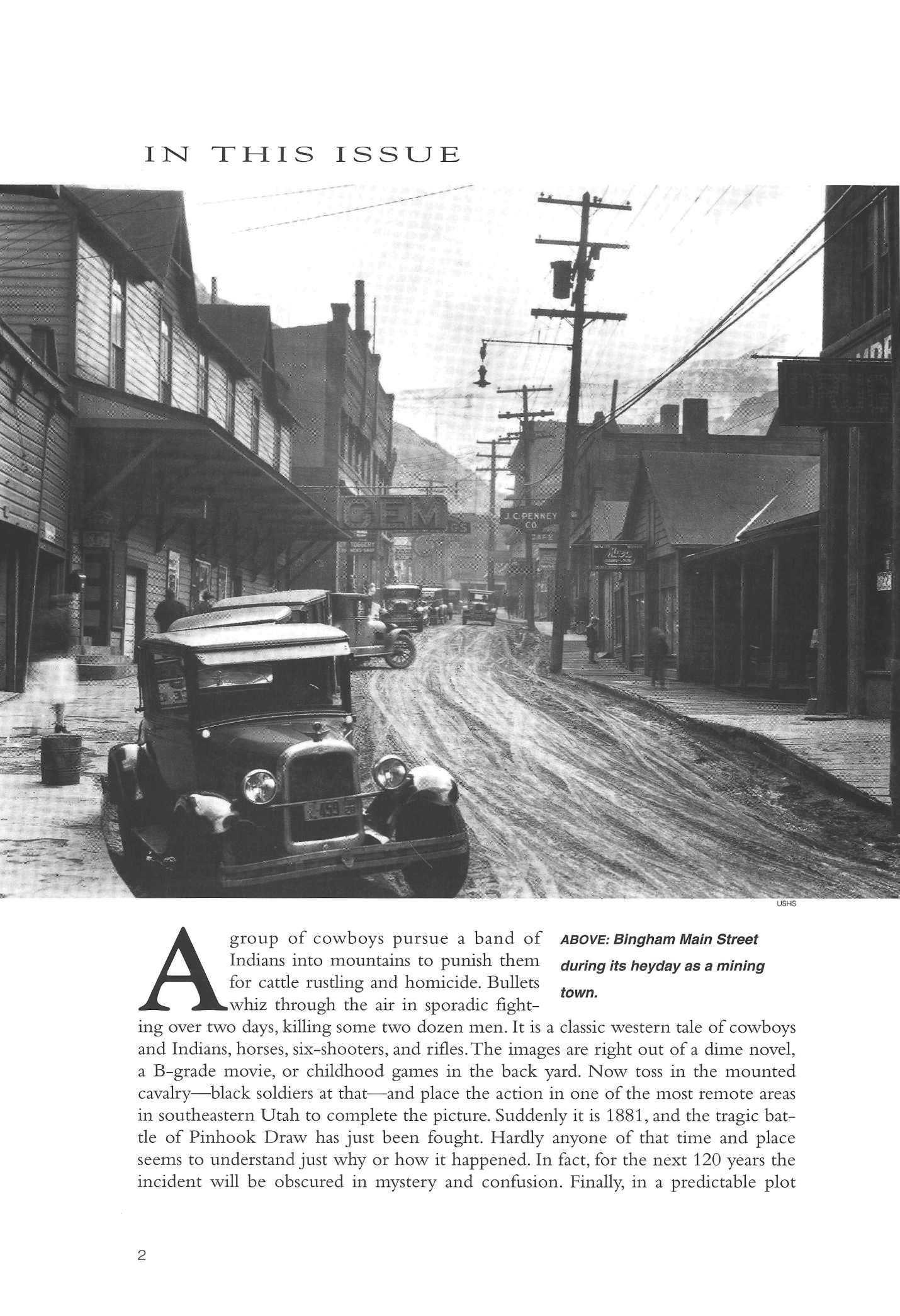
4 minute read
In This Issue
A group of cowboys pursue a band of Indians into mountains to punish them for cattle rustling and homicide. Bullets whiz through the air in sporadic fighting over two days, killing some two dozen men It is a classic western tale of cowboys and Indians, horses, six-shooters, and rifles The images are right out of a dime novel, a B-grade movie, or childhood games in the back yard. Now toss in the mounted cavalry—black soldiers at that—and place the action in one of the most remote areas in southeastern Utah to complete the picture Suddenly it is 1881,and the tragic battle of Pinhook Draw has just been fought Hardly anyone of that time and place seems to understand just why or how it happened. In fact, for the next 120 years the incident will be obscured in mystery and confusion. Finally, in a predictable plot twist, historians ride to the rescue—in this case, quite literally Two energetic and talented researchers travel to Pinhook Draw, walk the battle site with maps and documents in hand, and piece the story together. As finished and published here, it is a sobering but sensitive analysis of cultural conflict, racial prejudice, and personal violence—not pretty but gripping, detailed, and instructive A seminal work, it holds first spot among the offerings in this issue
Remaining fixed in the same region, we fast-forward through two-thirds of a century to look at the bustling community of Moab in 1948. Pickups and house trailers have replaced horses and cabins, Geiger counters have taken the place of firearms, and uranium has out-muscled the cattle industry as the main source of livelihood
Hundreds of new arrivals need places to stay, schools for their children, and telephones for calling friends and families in faraway places. The rush will continue. By 1950, the city's population will double its 1940 count; within another ten years, the population will triple The story of urban grown is an amazing one, but it has often received short shrift in the various histories of the uranium boom. Here in our second offering, a historian's lively prose sketches the processes by which the city officials and residents coped with shortages of water, housing, services, and medical facilities, all the while planning for the future It is an engaging tale of community cohesion and triumph, sprinkled with humor and anecdotes, that can be read and appreciated on several different levels.
Community building is also at the heart of the final two articles in this issue, though the emphasis is on medical services rather than infrastructure Bingham Canyon is the place, with its rich ethnic mix and unique setting adjacent to the enormous open pit copper mine Louise Van Ee Jager is the star of the first drama, which describes how, barely finished with nurses' training, she was hired as a public health nurse within the Jordan School District. Not fully prepared for the unique set of circumstances facing her, she nevertheless proved equal to every challenge over an eighteen-year period, tutoring children and parents in matters of hygiene and preventative medicine, overcoming language barriers and occasional suspicion, providing hospital assistance in times of emergency, and even herding a few cows along the way.
Among the many interesting people Louise met in Bingham Canyon was Paul S Richards, Bingham Canyon physician. Dr. Paul takes center stage for the concluding article.The historian's spotlight reveals him as an unassuming man with no makeup, costume, or script Having overcome a sickly childhood, he seemed to relate especially well to the struggling immigrant workers in the copper industry They responded in kind to him. Along with that rapport, Dr. Paul was able not only to build a hospital and provide everyday medical services to an appreciative community but also to establish a reputation as an innovator in industrial medicine His story, like that of Louise Van Ee Jager, is one of love—love of community, of service, and of fellow human beings.
The discipline of history was never intended to be a feel-good experience, but who in the world is going to complain if it serves that purpose every now and then?








